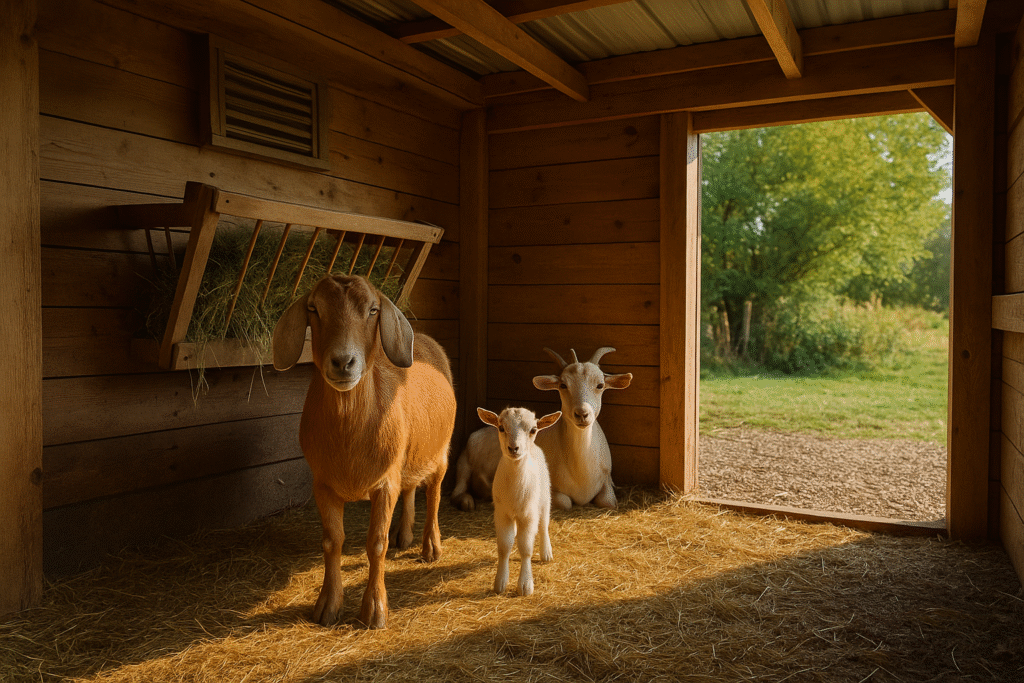
Best Goat Shelters in (2025): 4 Reliable Picks for Town Gardens & Country Acres
Why goat shelters matter (for both urban and rural people)
Goats are tough but they don’t like wet weather or scorching sun. A good goat shelter does three quiet jobs better than anything else on your homestead:
- Keeps animals dry and draft-free so they hold condition through rain, wind, and snow.
- Creates a predictable routine for feeding, night lock-up, and health checks.
- Protects kids and calm animals from bullying and predators when the rest of the world gets noisy.
(Affiliate disclosure: This post contains affiliate links. If you buy through the links below, I may earn a small commission at no extra cost to you.)
Whether you keep two dwarf goats behind a garage in town or a dozen dairy does on pasture, the right shelter reduces stress, cuts chore time, and prevents the sneaky problems that start with wet bedding, cramped corners, or rattly doors.
- Practical footprint: workable in a small city yard or scalable for a rural paddock.
- Ease of setup: straightforward assembly, sensible hardware, and replacement covers/parts when you need them.
- Value: enough shelter per dollar that you won’t outgrow it in a season.
1) Best Overall, Most Versatile — Large Animal Shelter
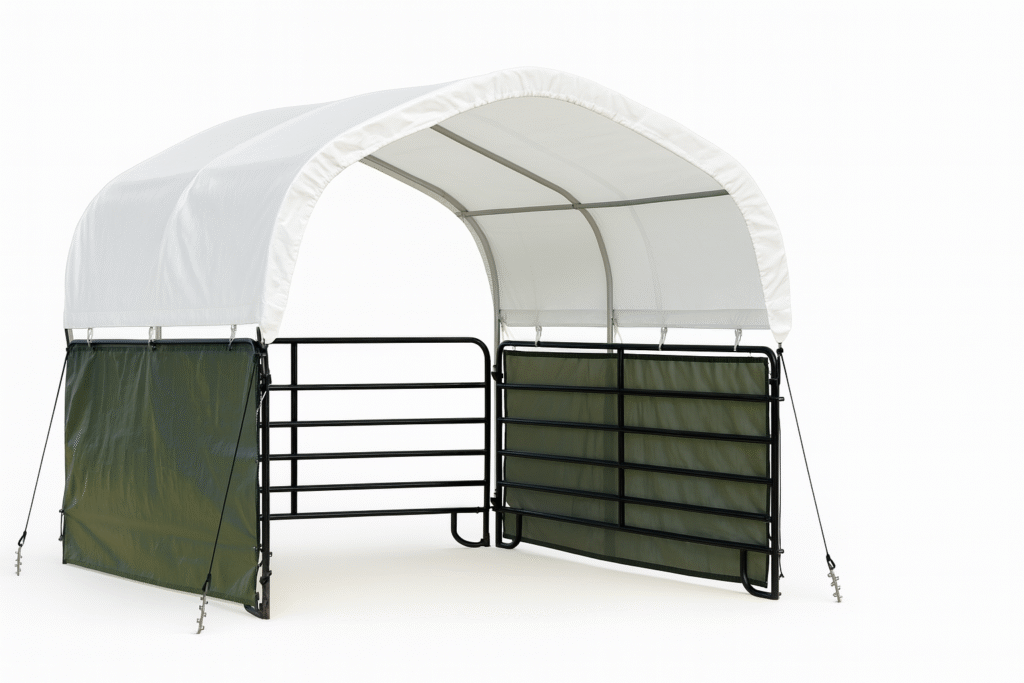
Why it’s a strong first choice:
- Sized for goats with headroom to spare, so airflow stays good and chores don’t turn into crouch-and-shuffle.
- Works as a run-in for day shade and storm cover, and converts easily into a night pen with panels or a gate.
- Straightforward to anchor and maintain; replacement covers/hardware are typically easy to source on Amazon.
Best for:
Urban owners who want a clean, professional look that neighbors won’t hate; rural keepers who need a dependable, semi-portable run-in that can also shelter hay or a milking stand.
Setup tips:
Anchor like you mean it (auger anchors or posts set below frost). Face the opening away from prevailing wind. Add kick boards or no-climb mesh along the bottom 24–36″ to limit rubbing and chewing.
2) Best for Small Yards & Kidding Corners — Compact Livestock Shelter
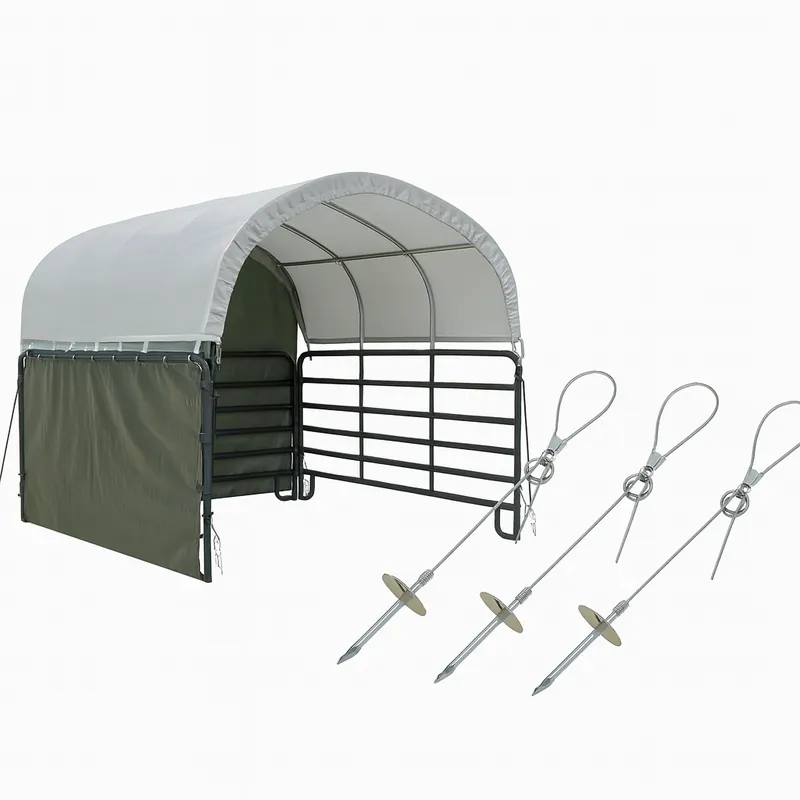
Why it’s handy in town:
- Compact footprint that fits neatly beside a garage or along a fence line.
- Quick to assemble, easy to re-site when your layout changes.
- With a couple of interior panels, it becomes a temporary kidding pen or a quiet recovery corner.
Best for:
Two to three small goats in an urban/suburban setting; as a dedicated kid shelter on rural properties; as a shade/quiet bay adjacent to your main run-in.
Setup tips:
Lay a gravel pad and rubber mats at the door to stop mud. If you use it as a night pen, install a two-step latch (carabiner + latch) so raccoons can’t “help.”
3) Best “Run-In Bay” for Rotations — Deep-Bay Animal Shelter
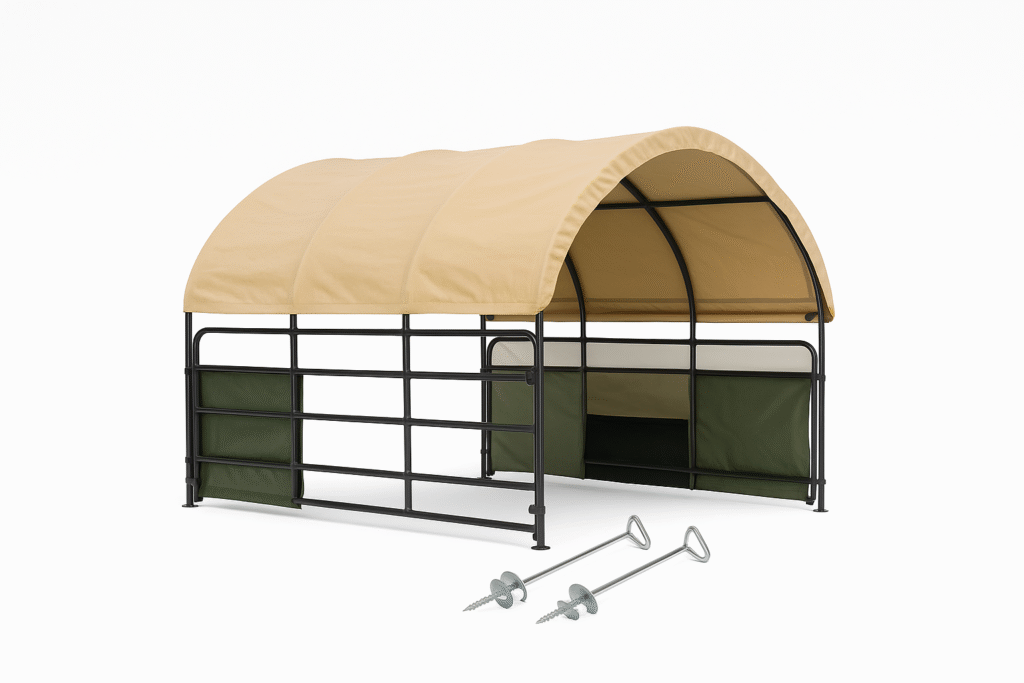
Why it’s great for pasture moves:
- Deeper roofline = better wind/rain shadow, which goats actually use during sideways storms.
- Enough headroom for hay storage along one side while goats lounge in the other.
- Pairs well with electric netting for rotational grazing—drop it at the new paddock, anchor, and you’ve got shade + storm cover day one.
Best for:
Rural herds rotating through several paddocks; small farmsteads that want a dual-use bay (goats + hay/equipment) under one roof.
Setup tips:
Anchor the four corners first, then add center/ridge bracing in wind/snow zones. Keep a clear, wide doorway and store hay off the ground along the sheltered wall.
4) Best Bundle for Quick Weather Protection — Livestock Shelter + Enclosure/Anchors
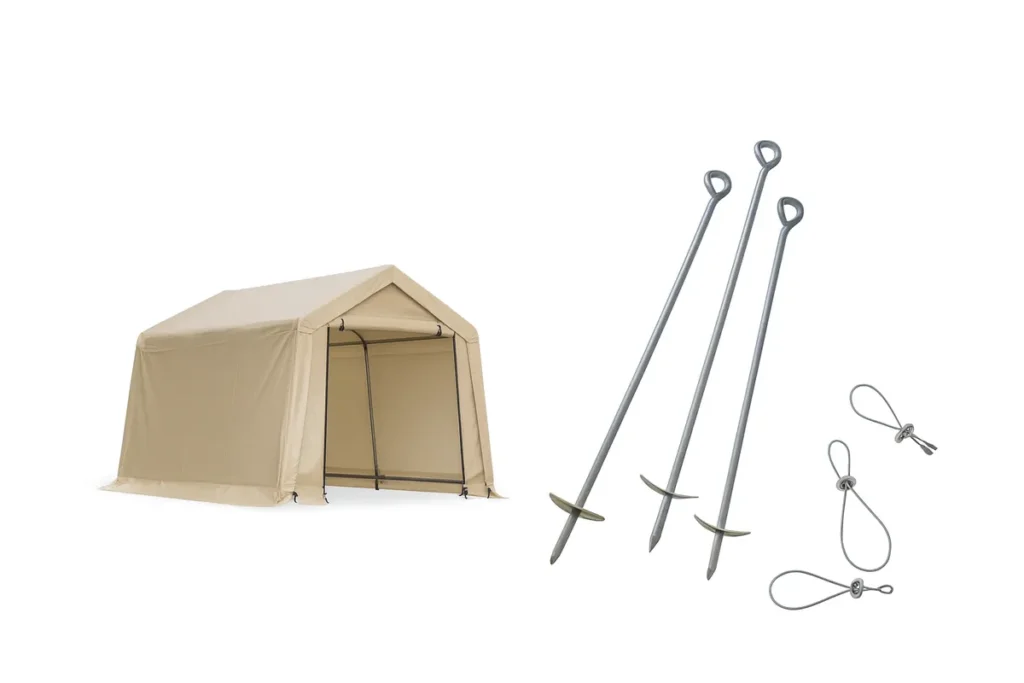
Why this bundle saves time:
- Includes the roof structure plus enclosure panels or curtains and ground anchors in one cart.
- Ideal when you want a night lock-up or a quiet bay that actually blocks wind from more than one direction.
- Useful as a quarantine or sick pen corner without building a new shed.
Best for:
New keepers who want an “all-in-one” experience; anyone who needs night security in coyote/dog country but doesn’t want to pour concrete yet.
Setup tips:
Mount doors/latches low-noise (no clanging) for urban neighbors. In the country, add a camera and motion light so you know who visited at 2 a.m.
5) Mobile Shade / Corral Roof — Corral-Style Shelter Cover
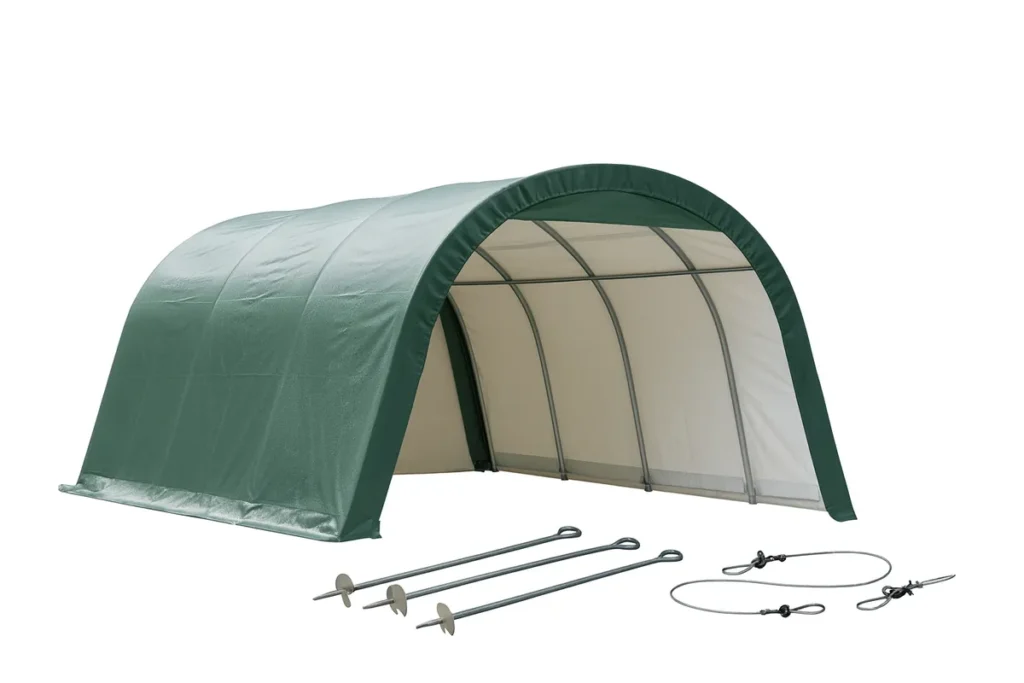
Why it’s the Swiss Army knife:
- A roof that clamps to panels you already own—great for pop-up shade, show pens, or temporary paddocks.
- Fastest to relocate and re-anchor as your grazing plan shifts.
- Ideal over a panel pen near the house during kidding season.
Best for:
People who already use livestock panels and want a tidy roof solution they can move with a hand truck.
Setup tips:
Because this style relies on your panels for structure, use heavy-duty panels and secure them with panel clamps (not just baling twine). Anchor the frame and the panel feet.
Important: Some listings are cover-only (you supply panels). Others include frames. Check the product page for “what’s in the box.”
Urban vs. Rural: which shelter fits where?
If you’re in a small urban/suburban yard
- Prioritize a compact footprint and a clean look (Picks #2 and #5).
- Keep the opening away from neighbors’ windows and use quiet hardware (no bangy chains).
- Lay a gravel/mat threshold—your future self will thank you every rainy week.
- Add a pop-up interior panel so you can convert part of the shelter to a kidding or “time-out” corner.
If you’re on a larger rural block
- Favor deeper run-ins (Pick #3) and the bundle with enclosure/anchors (Pick #4) for night lock-up.
- Put water and minerals under a roof on rubber mats by a wide gate—quicker chores, less mud.
- In predator country, consider a two-layer plan: sturdy shelter + perimeter fence with low hot offset wire.
- Size your anchors and bracing for wind/snow. Clearance over tractor forks beats regret later.
Sizing & layout (so the space actually works)
- Covered space: plan 10–15 sq ft (0.9–1.4 m²) per adult goat for a three-sided run-in; bump to 15–20 sq ft if goats will spend lots of storm time inside.
- Doorways: at least 4 ft (1.2 m) wide, or two smaller openings so timid goats can slip past queens and bosses.
- Line-of-sight: goats hate dead ends. If possible, design a walk-through from door to door or door to side panel.
- Floor: the winning combo is compacted gravel + rubber mats with a slight slope to the door. Deep straw or shavings over the top.
- Feed & water: rack at shoulder height; loose minerals under cover; water on a mat to stop the doorway turning to soup.
Anchoring & weatherproofing (non-negotiable)
- Anchor every corner. Auger anchors in soil; posts set below frost in permanent spots.
- Face the opening away from prevailing wind; use removable side curtains on the storm side.
- Add kick boards (2×8 lumber/ply) inside at hoof height to protect covers and reduce rubbing.
- Vent high, block low. Air should escape at the peak while drafts at sleeping level stay minimal.
- Snow/wind zones: add ridge/center bracing and clear roof loads after storms; re-tension covers seasonally.
Predator-smart habits (that also keep peace with neighbors)
- Close a night door (Pick #4 makes this easy) and use two-step latches.
- Keep feed in sealed bins; hang hay racks and mineral dishes under roof.
- Put a camera on the shelter corner; motion lights make honest neighbors of everyone.
- In town: pick quiet latches and rubber bumpers so doors don’t slam in the wind.
10-minute daily routine (that prevents 90-minute problems)
- Fork out wet spots, fluff bedding.
- Refill water; check the mat/threshold for mud.
- Top up minerals; scan hay rack for bent wires.
- Peek at vents (open enough to keep air clear).
- Glance at anchors/lashes; re-tension a loose strap.
- Quick goat headcount and look-over. Done.
Troubleshooting quick wins
- Damp/ammonia smell? Increase high venting, spot-clean, add a thin dry cap of straw/shavings.
- Goats won’t use the shelter? Improve light (clear panel, window under eave) and enlarge the opening.
- Wind sneaks in? Add a removable wind panel on the storm side, but keep ridge/soffit venting open.
- Chewing/rubbing on covers? Kick boards and toys/logs for rubbing; mineral balance (esp. copper) corrects some obsessive behaviors.
Comparison snapshot
| Pick | Best for | Why choose it | Link |
| #1 — Large Animal Shelter | “Do-everything” run-in | Roomy, versatile, easy to keep tidy | View on Amazon |
| #2 — Compact Livestock Shelter | Small yards, kidding corners | Fits tight spaces; easy to relocate | View on Amazon |
| #3 — Deep-Bay Animal Shelter | Rotations, rural lanes | Deeper roof = better storm cover | View on Amazon |
| #4 — Shelter + Enclosure Bundle | Night lock-up, quick weather fix | All-in-one package with anchors/curtains | View on Amazon |
| #5 — Corral-Style Roof | Mobile shade over panels | Quick to move; great above panel pens | View on Amazon |
If one goes out of stock, keep the category (compact run-in, deep-bay run-in, bundle/enclosure, corral roof) and swap a similar listing—your layout and anchoring practices matter more than the exact model.
Final thoughts
A great goat shelter isn’t complicated: high ground, dry floor, wide doorway, real airflow, and solid anchors. Pick the size and style that fits your space today and your herd tomorrow. The four (plus one) options above all cover the basics, but your habits make them sing—clean a little every day, keep wind and water out, and give goats a line of sight that feels safe.
When the first sideways rain finds your yard and your herd chooses the shelter—not your porch—you’ll know you picked the right one.
